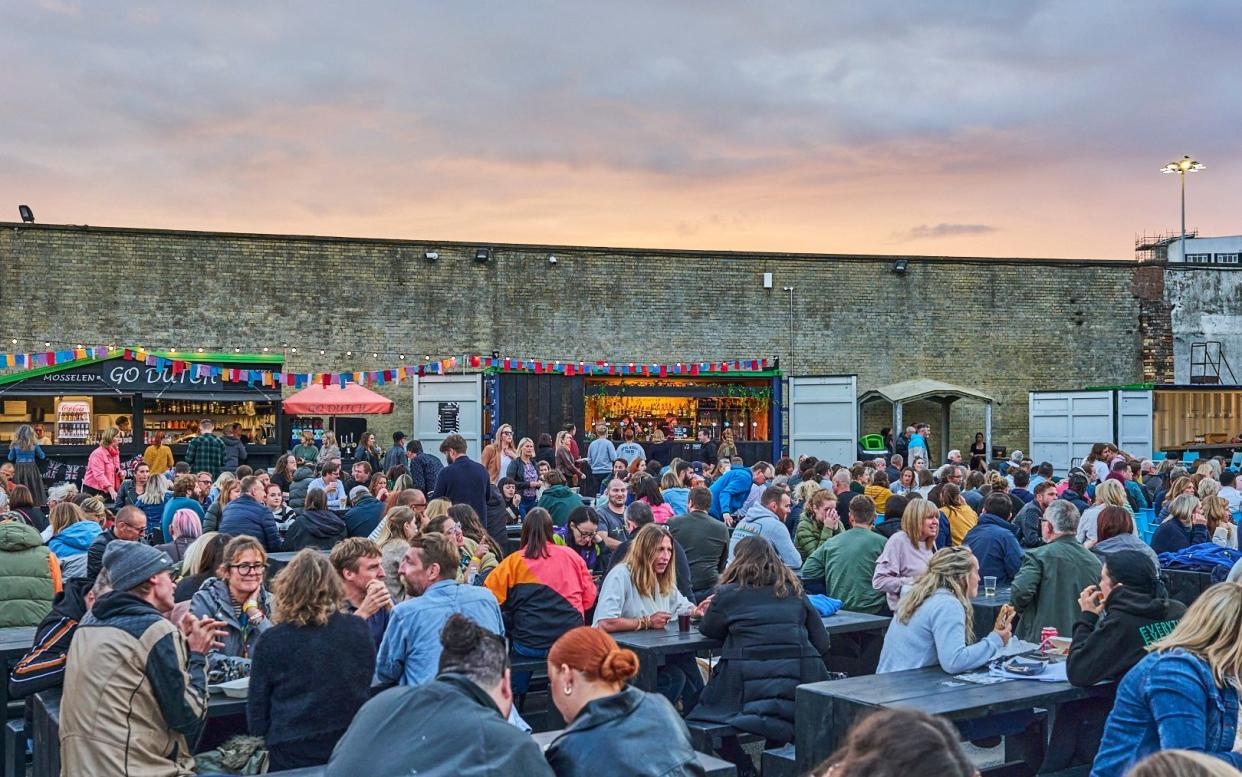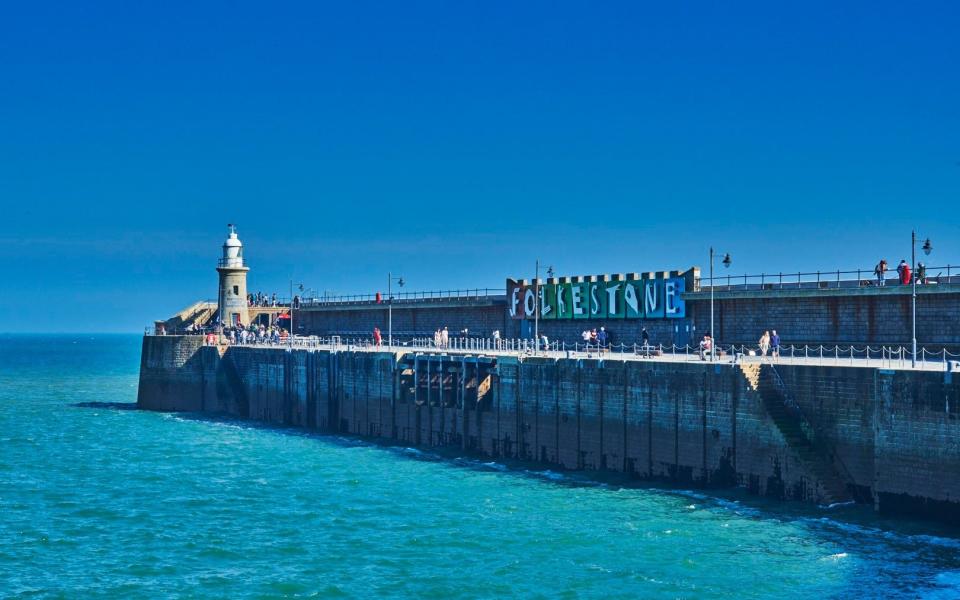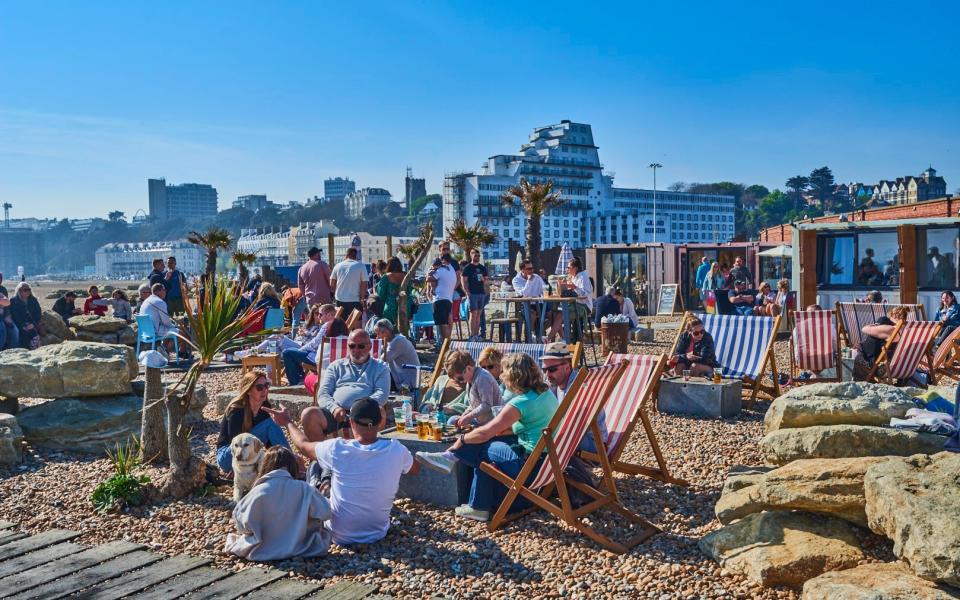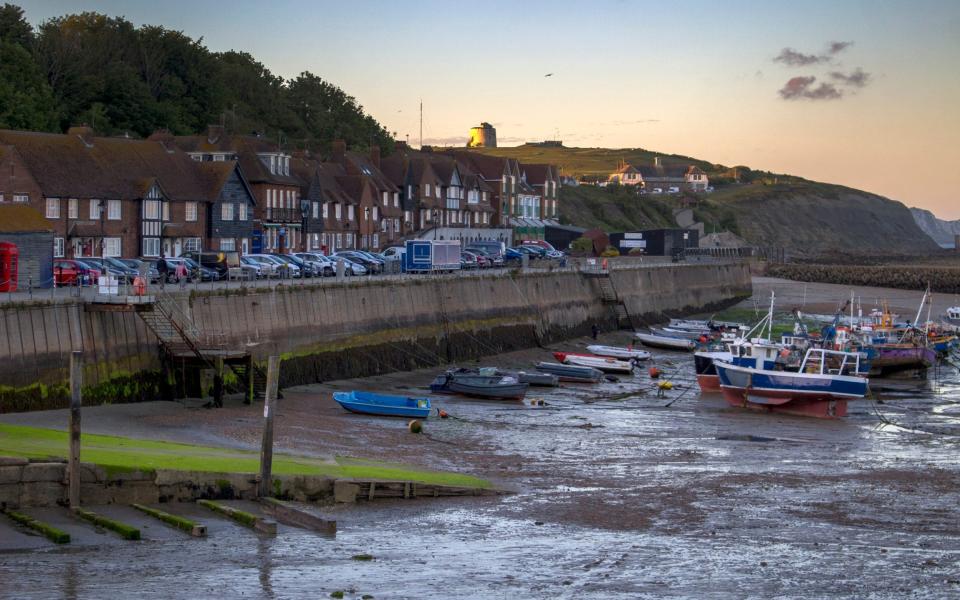The gritty rival to Margate that’s hoping to lure trendy Londoners

The Kent coast is packed with rapidly gentrifying seaside towns where DFLs (“Down From Londons” who’ve moved to the area) mingle with eager holidaymakers. At 10am on a gloomy morning in March, you might find them ordering a late breakfast on Deal’s wave-battered pier or sitting on the promenade at Broadstairs, staring out to sea with an artisan coffee in hand. You won’t, however, find them doing much in Folkestone at this hour because the town hasn’t quite woken up yet – either literally or metaphorically.
When I arrived after a long drive up the M20, there was only one cafe open in the Creative Quarter, which climbs upwards from the sea in a tightly-packed wiggle of art galleries, restaurants and vintage shops. Meanwhile, at Folkestone’s restored Harbour Arm (where bars, restaurants and an outdoor cinema straddle the old harbourside railway station), the outlets were shuttered and even the adventure golf course was closed.
Although signs of Folkestone’s gentrification are everywhere, it’s happening at a slower pace than elsewhere on the coast. House prices remain relatively low and there’s a lack of good hotels. Boutique B&Bs, artisan bakers and farm-to-table fare are thin on the ground, but if you need crystals or a natty secondhand jumper, you’ve definitely come to the right place. Despite, or perhaps because of all this, it’s hard not to fall for Folkestone’s half-reconstructed charms.

I walked for a while along the wavy beach boardwalk which links the harbour development with the promenades of the Lower Leas Coastal Park, following a breadcrumb trail of impressive seaside installations left behind by the town’s Triennial art festival – a jelly mould-style pavilion by the Turner Prize-winning Lubaina Himid here, a brightly-painted shelter by South American artist Sol Calero there.

Much of the recent investment in Folkestone has come from Sir Roger de Haan, the Saga founder whose parents owned a small hotel here. His foundation helped create the Creative Quarter and he is also behind The Folkestone Harbour Company, which began the transformation of the down-at-heel Harbour Arm back in 2011. Though deserted on my off-season visit, it has been deemed a success: in 2022, more than two million people headed to the regenerated area and seafront.
“I’ve worked here for six years and in that time the Folkestone Harbour Arm has gone from being this completely desolate thing to home to 60 businesses,” says Dan Johannsen, its Commercial Communications Manager. “At the moment, it’s weekends-only from January to March but new restaurant openings this year will create year-round trade.”
When the first two of the six slated restaurants open in May 2023, they’ll serve up brunches and Argentine steaks in shipping containers with floor-to-ceiling views of the White Cliffs and a hazy France in the distance. And in 2024, the Triennial will return, leaving more works behind for what has become the UK’s largest urban contemporary art exhibition.
Though nearby Margate tends to hog the arty limelight, this initiative has left permanent pieces by the likes of Anthomy Gormley and Tracey Emin around the town. Coming across a tiny bronze shoe on Sunny Sands beach (part of Emin’s 2008 contribution) feels like finding treasure. The next big reveal is Shoreline, a housing development I discovered at the end of the beach boardwalk, its scaly facade shimmering in the spring sun like a cross between a huge cuttlefish and a UFO.
It’s hoped that all this investment will return the town to its former glory. Folkestone was once among the most popular resorts on the English coast following a Victorian-era transformation spearheaded by the Radnor family, whose ancestors had bought the barony of the town back in the late 17th-century.

High at its westerly edge, sweeping stucco-fronted crescents and grand squares designed by Decimus Burton, the architect behind London Zoo, still smarten up the skyline in an echo of the multi-million pound homes he created in Regent’s Park. Heading towards them on The Zig Zag path, a century-old trail which spirals up from the seafront, felt like taking a passage back in time as I meandered through fanciful, man-made caves and caught vertigo-inducing views of the Channel framed by dainty wirework balconies.
At Folkestone’s lovingly-curated museum, I found more relics of the town’s rich past as well as discovering the key role it played in both World Wars. Unfortunately, Folkestone’s timeline goes downhill from there. Holidaymakers stopped coming once they could fly somewhere hotter, and in 2000 its last cross-Channel ferry left, taking a chunk of the town’s identity and income with it.

Back at the harbour, it’s impossible to miss the signs of recent neglect, most notably the great hulk of the Grand Burstin hotel, with a cruise liner-inspired 1980s frontage that’s yellowing with the decades. It replaced the grand Pavilion hotel, but an average TripAdvisor rating of 2.5 stars (out of five) tells its own story.
The Grand Burstin aside, the Harbour Arm is increasingly bringing sparkle back to the area. And just five minutes inland, Sandgate Road is a brilliant reminder that things do not always need to be polished in order to shine. Unlike the homogenised city centres in other towns, this stretch is a lovable hodgepodge of butchers, stationers and 1970s-style restaurants.

At Chaos Cards, you can pay £2 and spend the whole day playing myriad board games in the cavernous attic. When night falls, head a minute down the road to The Chambers for TexMex food and live music (there’s always a gig in Folkestone, the “world’s first Music Town” and home to a May festival that promises a lively mix of concerts, workshops and open-mic nights).
Right at the top of the new Creative Quarter I stumbled upon The Bayle “village”, once thought to be home to a priory built for the 7th-century Kentish princess, Eanswythe (she was later beatified and its flint-walled church still holds her bones as relics). Though the sleepy air was tempered by building work, not much seemed to have changed over the centuries.
A couple of proper pubs offered shelter from the sea breezes, and daffodil-packed window boxes trimmed houses painted in pastel colours. Inside the British Lion, Folkestone’s oldest drinking establishment, I tucked into a tasty Ploughmans against a backdrop of patterned carpet and plenty of dark wood and savoured the novelty of finding an inn that hadn’t been restyled to within an inch of its life.

You don’t have to wander far to find old-fashioned seaside charm either. Following the fishing boats round the harbour towards the Stade and the yellow curve of Sunny Sands, I later sauntered along cobbled streets where arches sheltered a much-loved seashell shop and Herberts ice cream parlour, famed for its Gypsy Tart ice cream. By Bob’s seafood stand, I watched the tide rise in the harbour and, along with it, a pink, cartoon-like house created by artist Richard Woods as part of his Holiday Home installation.
The Stade is home to the restaurant that first put Folkestone back on the map in 2011 – slick Rocksalt. Though it lost its Michelin-starred chef in 2021, it still draws a regular flow of visiting gourmands with a menu of crab, mussels and fresh fish served up in a very grown-up dining room. Sadly, like much of the rest of town, Rocksalt was closed when I visited. It’ll just have to wait for next time.


